Digital Transformation Market Overview
The global digital transformation market size was valued at USD 721.6 billion in 2022, and is projected to reach USD 6.8 trillion by 2032, growing at a CAGR of 25.4% from 2023 to 2032. The key factors that drive the digital transformation market growth include rise in adoption of industrial robots and growth in usage of mobile devices and apps. The rise in the adoption of industrial robots is a pivotal growth factor for the digital transformation industry.
Key Market Trends & Insights
- By technology, Big data and business analytics segment held major share in the market in 2022.
- By deployment mode, the cloud is expected to witness the fastest CAGR from 2023 to 2032
- Region wise, Asia-Pacific is expected to witness the fastest CAGR during 2023 to 2032
Market Size & Forecast
- 2032 Projected Market Size: USD 6.8 Trillion
- 2022 Market Size: USD 721.6 Billion
- Compound Annual Growth Rate (CAGR) (2023-2032): 25.4%
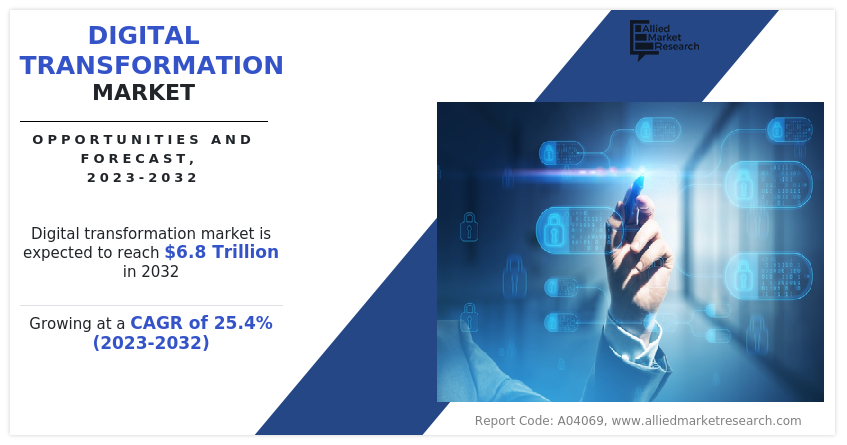
Industrial robots, equipped with advanced sensors, AI, and connectivity capabilities, have revolutionized the manufacturing and industrial sectors. They play a crucial role in automating processes, enhancing efficiency, and enabling a broader digital transformation across various industries. In addition, increase in use of digital experience platforms (DXPs) to enhance the customer experience is considered an important factor to boost the market. However, data privacy and security concerns associated with digital technologies are expected to hamper market growth.
Data privacy and security concerns pose significant restraints on digital transformation initiatives. The migration of data and applications to the cloud introduces concerns about data security and control. Organizations must address these challenges to maintain data integrity and privacy. Contrarily, high usage of digital transformation in healthcare sector contributes significantly to the growth of the digital transformation market. Telemedicine and remote patient monitoring have gained significant traction, enabling healthcare providers to reach patients wherever they are. This transformation in care delivery requires advanced digital technologies and connectivity. Hence, these factors are expected to drive the growth of the market during the forecast period.
Introduction
Digital transformation is the incorporation of computer-based technologies into products, processes, and strategies of an organization. Organizations undertake digital transformation to better engage and serve their workforce and customers and thus improve their ability to compete.
Digital Transformation Market Segment Review
The global digital transformation market is segmented on the basis of component, deployment mode, enterprise size, technology, industry vertical, and region. On the basis of component, the market is bifurcated into solution, and service. On the basis of deployment mode, the market is bifurcated into on-premise, and cloud. On the basis of enterprise size, the market is bifurcated into large enterprises and small and medium-sized enterprises.
On the basis of technology, it is divided into artificial intelligence, cloud computing, blockchain, big data and business analytics, cybersecurity, and others. Big data and business analytics segment held major share in digital transformation market in 2022.
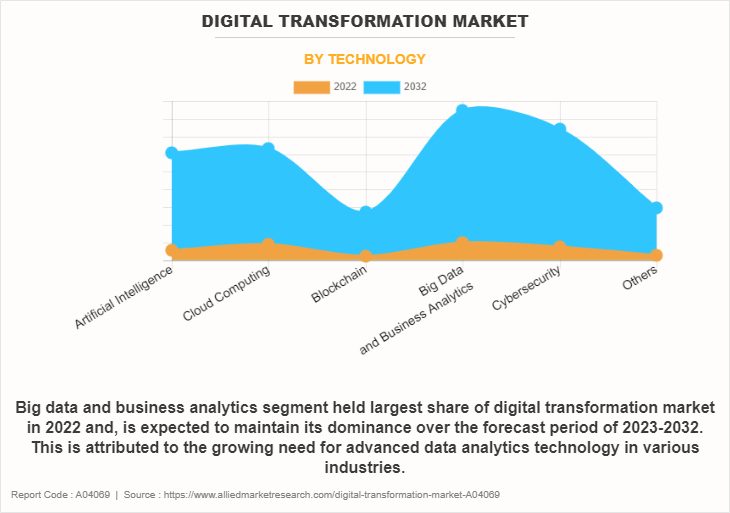
On the basis of deployment mode, the market is bifurcated into on-premise and cloud. On-premise segment held major share of the digital transformation market size in 2022. the cloud is expected to witness the fastest CAGR from 2023 to 2032. The significant growth can be attributed to advancements in information-sharing technologies and the increase in use of mobile devices. Cloud-based digital transformation solutions facilitate effective and efficient ways to adapt to evolving market environments.
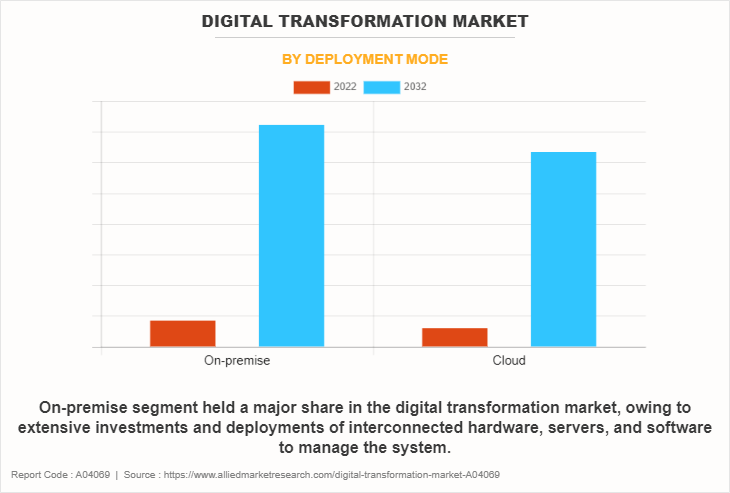
On the basis of region, digital tarnsformation market is segmented into North America, Europe, Asia-Pacific, and LAMEA. Asia-Pacific is expected to witness the fastest CAGR from 2023 to 2032. This is owing to the growth in adoption of AI-driven advanced analytics tools and IoT-based sensors and devices to offer personalized services for both B2C and B2B consumers. This is one of the major factors contributing to the growth of the regional digital transformation market.
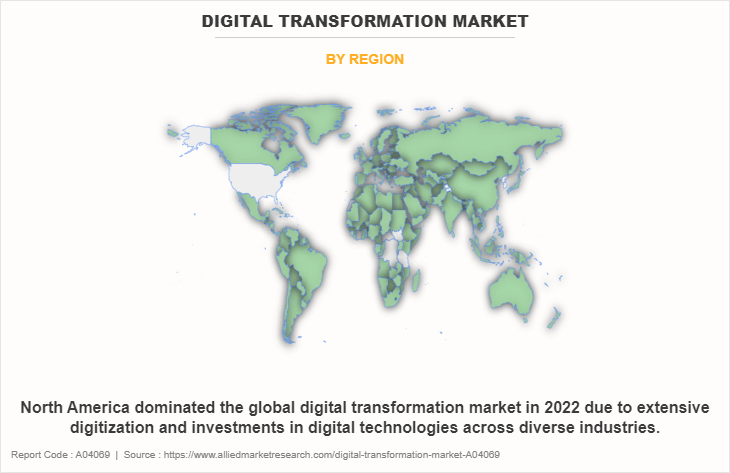
On the basis of component, the market is bifurcated into solution and service. In 2022, solution segment dominated the digital transformation market share.
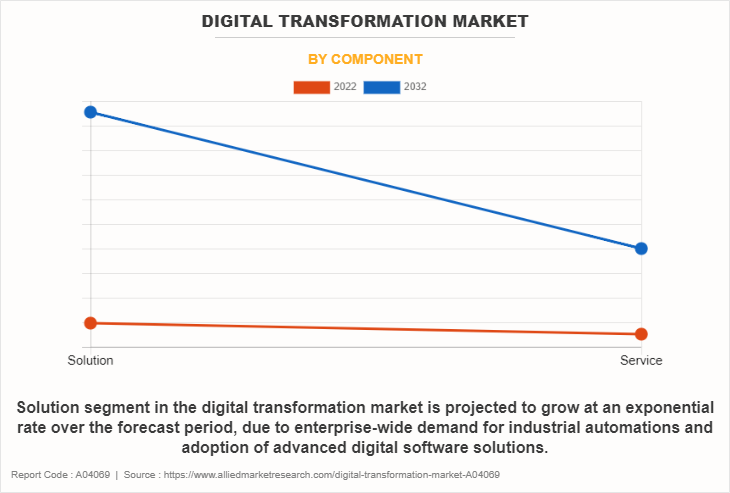
On the basis of enterprise size, the market is bifurcated into large enterprises and small and medium-sized enterprises (SMEs). SMEs segment is anticipated to grow at an exponential growth rate in the digital transformation market.
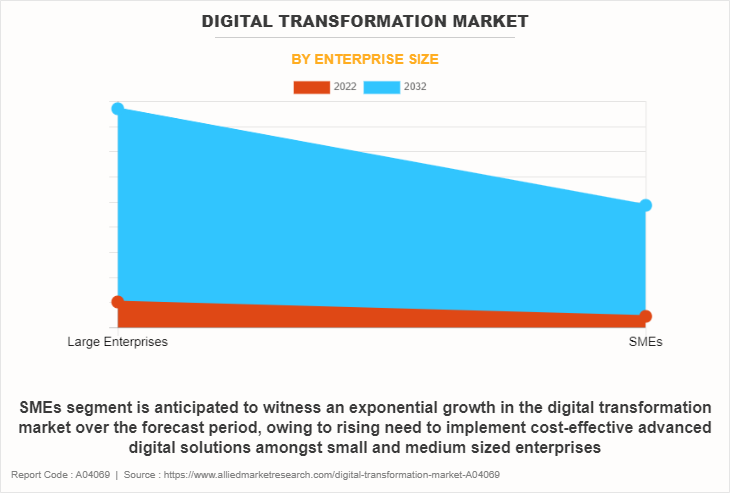
On the basis of industry vertical, the digital transformation market is divided into BFSI, retail and e-commerce, IT and telecom, healthcare and life sciences, government and defense, and others. In 2022, IT and telecom held a substantial share in market.
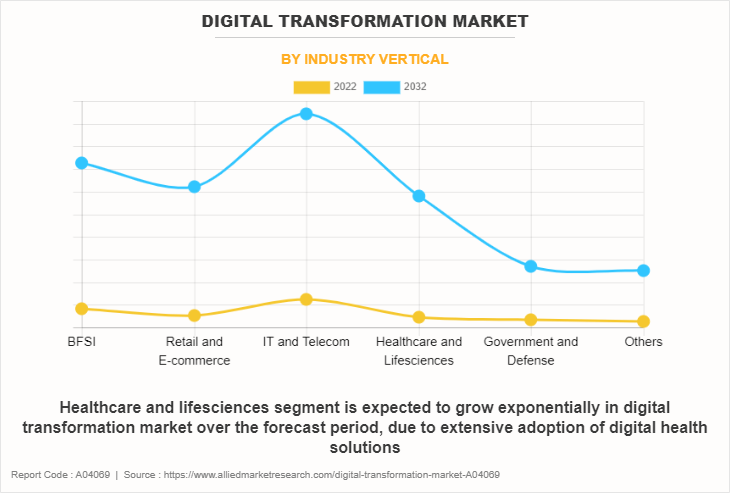
The report focuses on growth prospects, restraints, and trends of the market analysis. The study provides Porter’s five forces analysis to understand the impact of various factors, such as bargaining power of suppliers, competitive intensity of competitors, threat of new entrants, threat of substitutes, and bargaining power of buyers, on the market.
What are the Top Impacting Factors in Market
Market Driver
Increase in Use of Digital Experience Platforms (DXPs) to Enhance the Customer Experience
The growth in use of digital experience platforms (DXPs) to enhance the customer experience is a significant driver of the digital transformation market. DXPs are comprehensive solutions that empower organizations to create and manage consistent, personalized, and engaging digital experiences for their customers across various touchpoints. DXPs enable businesses to collect, analyze, and leverage customer data to create highly personalized and relevant experiences. They use data-driven insights to understand individual preferences, behaviors, and needs, allowing for tailored content and services.
In addition, digital technologies have accelerated drug discovery and clinical research. Researchers can leverage AI, big data, and simulations to expedite the development of new treatments. Furthermore, end-user companies have partnered with industry players to implement DXPs in their business models. For instance, in August 2021, CoStrategix collaborated with DXP provider Optimizely to enable its clients to create customer-first digital experiences. In addition, CoStrategix easily integrated the Optimizely DXP platform into its existing cloud platform to make efficient data-driven decisions, supporting digital transformation market growth.
Growth in Usage of Mobile Devices and Apps
The increase
In addition, the rise of mobile wallets and payment apps has changed the way consumers do business. Companies have integrated mobile payment options to meet the demands of their customers. Since, the mobile app ecosystem has become more diverse and robust, providing businesses with opportunities to integrate with apps and third-party services, creating new value for users. Thus, these factors boost digital transformation market growth.
Rise in Adoption of Industrial Robots
The rise in the adoption of industrial robots is a pivotal growth factor for the digital transformation industry. Industrial robots, equipped with advanced sensors, AI, and connectivity capabilities, have revolutionized the manufacturing and industrial sectors. They play a crucial role in automating processes, enhancing efficiency, and enabling a broader digital transformation across various industries. Moreover, the data collected by industrial robots can be analyzed to predict when maintenance is needed. This proactive approach minimizes downtime and reduces maintenance costs.
In addition, industrial robots are expected to play an essential role in these systems as robots operate several critical functions in industries. Manufacturers have implemented various robots to execute repetitive actions, thus escalating the digital transformation market size. For instance, in 2021, according to the International Federation of Robotics (IFR), nearly 517,385 autonomous automotive and industrial robots were installed in factories across the globe. This rose by 31% year-over-year and 22% higher than the 2018 record for robot installation, before the pandemic. Currently, around 3.5 million operational robots are available globally.
Restraints
Data Privacy and Security Concerns Associated with Digital Technologies
Data privacy and security concerns pose significant restraints on digital transformation initiatives. The migration of data and applications to the cloud introduces concerns about data security and control. Organizations must address these challenges to maintain data integrity and privacy. In addition, many organizations rely on third-party vendors and partners for various digital services. These relationships can introduce additional security risks, particularly if the third parties do not adhere to robust security practices.
Furthermore, security concerns for enterprise data are a major concern during the adoption of digital technologies. IoT, cloud, AI, and blockchain technologies have spread at a rapid pace, which requires better protection and privacy to minimize cyber-attacks and data breaches. For instance, according to the Trustwave Global Security Report in 2022, the Common Vulnerabilities and Exposures (CVEs) were only 36% of 2021 CVEs, registering 5% increase in critical vulnerabilities as compared to 13% in 2021.
Opportunity
High Usage of Digital Transformation in Healthcare Sector
Telemedicine and remote patient monitoring have gained significant traction, enabling healthcare providers to reach patients wherever they are. This transformation in care delivery requires advanced digital technologies and connectivity. Furthermore, the use of telemedicine and remote assessment solutions allows patients to receive care from the comfort of their own homes. This is especially important in public health concerns. In addition, the development of digital transformation platforms are expected to
lenable healthcare professionals to offer virtual consultations, manage appointments and communicate securely with patients.In addition, digital technology enhances medical imaging, making it easier to capture, store, and share medical images. Diagnostic accuracy is also being enhanced through digital tools. Therefore, these factors are expected to drive the growth of the digital transformation market during the forecast period.
Increase in Adoption of Industry 4.0 Technology
The growth in adoption of IoT technology across end-user industries, such as manufacturing, automotive, and healthcare, has positively driven the market growth. internet of thingsIoT has fueled the next industrial revolution of intelligent connectivity with the traditional manufacturing sector amid a digital transformation. This has changed how industries approach increasingly complex processes of systems and machines to improve efficiency and reduce downtime. In addition, industry 4.0 technologies enable smart manufacturing processes by automating tasks, optimizing production, and providing real-time insights into operations.
Moreover, the integration of IoT sensors and devices allows real-time monitoring of machinery, inventory, and supply chains. This connectivity enhances data collection and process control. Furthermore, automation, and AI technological proliferation have played a vital role in creating new opportunities for organizations to streamline the process and improve productivity, supporting the digital transformation market growth with the shifting focus of end-user companies on remote working & digital workplaces.
Which are the Leading Companies in Digital Transformation Companies:
The following are the leading companies in the digital transformation market. These players have adopted various strategies such as collaboration, acquisition, and product launch to increase their market penetration and strengthen their position in the market.
Accenture Plc
Adobe Systems Inc.
Cognizant Technology Solutions Corporation
Google Inc
HCL Technologies Limited
Hewlett Packard Enterprise Development LP
IBM Corporation
Microsoft Corporation
Oracle Corporation
SAP SE.
Market Landscape and Trends:
The COVID-19 pandemic has forced businesses to opt for cloud technologies for remote working. This has resulted in the growth in demand for cloud services for business continuity. In addition, with the growth in number of remote workers, more businesses are being conducted using email and collaboration & digital tools, which is expected to drive the growth of the digital transformation market. Moreover, the development of smart cities involves integrating digital technologies to improve urban living through efficient transportation, energy management, and public services.
Further, AI and ML have become integral to digital transformation. They enable automation, data analysis, and predictive insights. In 2021, businesses were increasingly leveraging AI for chatbots, predictive analytics, and decision support systems. This trend continued, with AI adoption expanding into more sectors and applications. In addition, the global IoT demand trend is expected to shift toward the industrial space from consumer demand over the coming years, with sheer volume demand driven by various Industry 4.0 applications. A significant share of the demand is expected to drive the manufacturing industries, energy, business mobility, healthcare, and supply chain, which is expected to fuel the market growth during the forecast period.
Digital Transformation Industry Regional Insights:
The digital transformation market is expanding rapidly across various regions, driven by advancements in technology and the increasing need for businesses to adapt to digital ecosystems.
In North America Digital Transformation Market, particularly in the U.S. and Canada, the Market is highly developed. Large enterprises are heavily investing in cloud computing, artificial intelligence (AI), and data analytics to enhance operational efficiency and customer experience. The presence of major technology companies such as Microsoft, Amazon Web Services, and IBM has further accelerated digital transformation initiatives in the region. North American companies prioritize innovation and are quick to adopt digital solutions to maintain a competitive edge in the global digital transformation market.
In Europe Digital Transformation Market, the market is also growing steadily, particularly in Western European countries like Germany, the UK, and France. The European Union’s regulatory frameworks, such as the General Data Protection Regulation (GDPR), have encouraged businesses to invest in secure and compliant digital transformation strategies. Additionally, European companies are focusing on Industry 4.0 technologies, such as automation, IoT, and advanced manufacturing solutions, which are transforming traditional industries like automotive, manufacturing, and healthcare. The region’s strong emphasis on sustainability has also led to the adoption of digital solutions to reduce environmental impacts and improve efficiency.
In the Asia-Pacific region Digital Transformation Market, the digital transformation market is experiencing the fastest growth, driven by emerging economies such as China, India, and Southeast Asian countries. The rapid rise of e-commerce, mobile internet usage, and smart city initiatives has fueled demand for digital transformation across industries. Government programs like China’s Made in China 2025 and India’s Digital India campaign are also accelerating the adoption of digital technologies. As a result, companies in the region are investing in cloud infrastructure, AI, and blockchain to enhance productivity and meet the demands of a tech-savvy population.
Overall, the market is evolving differently across regions, with unique drivers and challenges shaping growth in each area.
Competition Analysis:
Recent Partnerships in the Digital Transformation Market
In September 2023, Parle collaborated with IBM, to drive digital transformation using cloud and AI. By deploying cloud and Artificial Intelligence (AI) for business solutions through the course of engagement, Parle has been able to reduce sourcing cost, enhance sales forecast accuracy, lower cost to serve and optimize overall IT infrastructure.
In May 2023, SAP partnered with Google Cloud, to introduce a comprehensive open data offering designed to simplify data landscapes and unleash the power of business data.
In January 2023, HDFC Bank partnered with Microsoft, as part of its digital transformation journey. HDFC Bank as a part of its future ready strategy is developing in house IPs as well as partnering with several companies including to co-create technology IPs of FinTechs.
In April 2021, Broadcom partnered with Google, to accelerate innovation and strengthen cloud services integration within the core software franchises of Broadcom.
What are the Key Benefits for Stakeholders:
This report provides a quantitative analysis of the market segments, current trends, estimations, and dynamics of the digital transformation market forecast analysis from 2022 to 2032 to identify the prevailing digital transformation market opportunities.
The market research is offered along with information related to key drivers, restraints, and opportunities.
Porter's five forces analysis highlights the potency of buyers and suppliers to enable stakeholders make profit-oriented business decisions and strengthen their supplier-buyer network.
In-depth analysis of the market segmentation assists to determine the prevailing digital transformation market opportunities.
Major countries in each region are mapped according to their revenue contribution to the global market.
Market player positioning facilitates benchmarking and provides a clear understanding of the present position of the market players.
The report includes the analysis of the regional as well as global digital transformation market trends, key players, market segments, application areas, and market growth strategies.
Digital Transformation Market Report Highlights
| Aspects | Details |
| Market Size By 2032 | USD 6.8 trillion |
| Growth Rate | CAGR of 25.4% |
| Forecast period | 2022 - 2032 |
| Report Pages | 450 |
| By Deployment Mode |
|
| By Component |
|
| By Enterprise Size |
|
| By Industry Vertical |
|
| By Technology |
|
| By Region |
|
| Key Market Players | SAP SE, Accenture plc, IBM Corporation, Adobe Systems Inc, Google Inc., Hewlett Packard Enterprise Development LP, Microsoft Corporation, Cognizant, Oracle Corporation, HCL Technologies Limited |
Analyst Review
As per the insights of the top-level CXOs, digital transformation involves digital technology into several areas of a business, primarily changing how businesses operate and deliver value to consumers. Digital transformation can simplify, integrate, and transform daily business operations by increasing performance proficiently. Moving from a conventional setup to a new digitalized setup helps introduce several technically advanced services and products. In addition, the increase in demand for digital and automated technologies across the manufacturing sector has surged rapidly in last few years. Manufacturers have progressively adopted the latest technologies to digitalize and automate the process to increase the quality and productivity of products. Furthermore, the shift to cloud computing is a significant trend. Companies have increasingly moved their infrastructure and applications to the cloud to improve flexibility, scalability, and cost-efficiency. This migration is expected to be continued, with a focus on multi-cloud and hybrid cloud solutions. Moreover, with the growth in number of remote workers, more businesses are being conducted using email and collaboration & digital tools, which is expected to drive the growth of the market.
The CXOs further added that market players have adopted strategies such as partnership for enhancing their services in the market and improving customer satisfaction. For instance, in November 2021, Google Cloud LLC, a provider of cloud infrastructure for AI-related services, partnered with Cohere, an advanced Natural Language Processing (NLP) technology provider. Cohere procured services of Google Cloud, such as ML and AI infrastructure, through this partnership. This service helped both companies to seamlessly deploy NLP applications on Google Cloud platform. Such strategies are anticipated to boost the growth of the digital transformation market.
Some of the key players profiled in the report include Accenture Plc, Adobe Systems Inc., Cognizant Technology Solutions Corporation, Google Inc, HCL Technologies Limited, Hewlett Packard Enterprise Development LP, IBM Corporation, Microsoft Corporation, Oracle Corporation and SAP SE. These players have adopted various strategies to increase their market penetration and strengthen their position in the Digital Transformation market.
The global digital transformation market size was valued at USD 721.6 billion in 2022, and is projected to reach USD 6.8 trillion by 2032
The digital transformation market is projected to grow at a compound annual growth rate of 25.4% from 2023-2032 reach USD 6.8 trillion by 2032
Google Inc., Microsoft Corporation, IBM Corporation, Oracle Corporation and Hewlett Packard Enterprise Development LP are the top companies to hold the market share in Digital Transformation.
North America is the largest regional market for Digital Transformation.
Extensive adoption of IoT integration and AI-driven automation are the upcoming trends of Digital Transformation Market in the world
Loading Table Of Content...
Loading Research Methodology...



